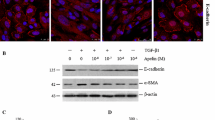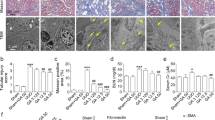Abstract
Fibrosis is induced by the excessive and abnormal deposition of extracellular matrix (ECM) with various growth factors in tissues. Transforming growth factor-β1 (TGF-β1), the growth factor involved in fibrosis, modulates ECM synthesis and accumulation. TGF-β1 enhances the production of stimulators of ECM synthesis such as plasminogen activator inhibitor type 1 (PAI-1). As such, PAI-1 expression directly influences the proteolysis, invasion, and accumulation of ECM. It was shown in this study that ascochlorin, a prenylpenl antiobiotic, prevents the expression of profibrotic factors, such as PAI-1 and collagen type I, and that the TGF-β1-induced PAI-1 promoter activity is inhibited by ascochlorin. Ascochlorin abolishes the phosphorylation of the EGFR-MEK-ERK signaling pathway to regulate the TGF-β1-induced expression of PAI-1 without the inhibition of TβRII phosphorylation. Furthermore, the MEK inhibitor and EGFR siRNA block PAI-1 expression, and the Raf-1, MEK, and ERK signaling pathways for the regulation of PAI-1 expression. Ascochlorin suppresses the matrix metalloproteinases (MMPs) activity to activate the heparin-binding EGF-like growth factor (HB-EGF), to induce the phosphorylation of EGFR, and the MMPs inhibitor suppresses EGFR phosphorylation and the PAI-1 mRNA levels. These results suggest that ascochlorin prevents the expression of PAI-1 via the inhibition of an EGFR-dependent signal transduction pathway activated by MMPs.




Similar content being viewed by others
Abbreviations
- PAI-1:
-
Plasminogen activator inhibitor-1
- EGFR:
-
Epidermal growth factor receptor
- MMP:
-
Matrix metalloproteinase
- TGF-β:
-
Transforming growth factor-β
References
Li F, Zeng B, Chai Y, Cai P, Fan C, Cheng T (2009) The linker region of Smad2 mediates TGF-beta-dependent ERK2-induced collagen synthesis. Biochem Biophys Res Commun 386:289–293. doi:10.1016/j.bbrc.2009.05.084
Verrecchia F, Mauviel A (2004) TGF-beta and TNF-alpha: antagonistic cytokines controlling type I collagen gene expression. Cell Signal 16:873–880. doi:10.1016/j.cellsig.2004.02.007
Dong C, Zhu S, Wang T, Yoon W, Goldschmidt-Clermont PJ (2002) Upregulation of PAI-1 is mediated through TGF-beta/Smad pathway in transplant arteriopathy. J Heart Lung Transplant 21:999–1008. doi:10.1016/S1053-2498(02)00403-5
Cho HJ, Kang JH, Kim T, Park KK, Kim CH, Lee IS, Min KS, Magae J, Nakajima H, Bae YS, Chang YC (2009) Suppression of PAI-1 expression through inhibition of the EGFR-mediated signaling cascade in rat kidney fibroblast by ascofuranone. J Cell Biochem 107:335–344. doi:10.1002/jcb.22130
Shi Y, Massague J (2003) Mechanisms of TGF-beta signaling from cell membrane to the nucleus. Cell 113:685–700. doi:10.1016/S0092-8674(03)00432-X
Tahashi Y, Matsuzaki K, Date M, Yoshida K, Furukawa F, Sugano Y, Matsushita M, Himeno Y, Inagaki Y, Inoue K (2002) Differential regulation of TGF-beta signal in hepatic stellate cells between acute and chronic rat liver injury. Hepatology 35:49–61. doi:10.1053/jhep.2002.30083
Verrecchia F, Mauviel A (2002) Transforming growth factor-beta signaling through the Smad pathway: role in extracellular matrix gene expression and regulation. J Invest Dermatol 118:211–215. doi:10.1046/j.1523-1747.2002.01641.x
Mulsow JJ, Watson RW, Fitzpatrick JM, O’Connell PR (2005) Transforming growth factor-beta promotes pro-fibrotic behavior by serosal fibroblasts via PKC and ERK1/2 mitogen activated protein kinase cell signaling. Ann Surg 242:880–887. doi:10.1097/01.sla.0000189606.58343.cd discussion 887–889
Hayashida T, Poncelet AC, Hubchak SC, Schnaper HW (1999) TGF-beta1 activates MAP kinase in human mesangial cells: a possible role in collagen expression. Kidney Int 56:1710–1720. doi:10.1046/j.1523-1755.1999.00733.x
Hanafusa H, Ninomiya-Tsuji J, Masuyama N, Nishita M, Fujisawa J, Shibuya H, Matsumoto K, Nishida E (1999) Involvement of the p38 mitogen-activated protein kinase pathway in transforming growth factor-beta-induced gene expression. J Biol Chem 274:27161–27167. doi:10.1074/jbc.274.38.27161
Lee HB, Ha H (2005) Plasminogen activator inhibitor-1 and diabetic nephropathy. Nephrology (Carlton) 10 Suppl:S11–S13. doi:10.1111/j.1440-1797.2005.00449.x
Rerolle JP, Hertig A, Nguyen G, Sraer JD, Rondeau EP (2000) Plasminogen activator inhibitor type 1 is a potential target in renal fibrogenesis. Kidney Int 58:1841–1850. doi:10.1111/j.15231755.2000.00355.x
Providence KM, White LA, Tang J, Gonclaves J, Staiano-Coico L, Higgins PJ (2002) Epithelial monolayer wounding stimulates binding of USF-1 to an E-box motif in the plasminogen activator inhibitor type 1 gene. J Cell Sci 115:3767–3777. doi:10.1242/jcs.00051
Providence KM, Staiano-Coico L, Higgins PJ (2003) A quantifiable in vitro model to assess effects of PAI-1 gene targeting on epithelial cell motility. Methods Mol Med 78:293–303. doi:10.1385/1-59259-332-1:293
Gaedeke J, Noble NA, Border WA (2005) Curcumin blocks fibrosis in anti-Thy 1 glomerulonephritis through up-regulation of heme oxygenase 1. Kidney Int 68:2042–2049. doi:10.1111/j.1523-1755.2005.00658.x
Sasaki H, Hosokawa T, Sawada M, Ando K (1973) Isolation and structure of ascofuranone and ascofranol, antibiotics with hypolipidemic activity. J Antibiot (Tokyo) 26:676–680
Sawada M, Hosokawa T, Okutomi T, Ando K (1973) Hypolipidemic property of ascofuranone. J Antibiot (Tokyo) 26:681–686
Hosokawa T, Okutomi T, Sawada M, Ando K, Tamura G (1981) Unusual concentration of urine and prevention of polydipsia by fungal prenylphenols in DOCA hypertensive rats. Eur J Pharmacol 69:429–438. doi:10.1016/0014-2999(81)90446-5
Magae J, Hayasaki J, Matsuda Y, Hotta M, Hosokawa T, Suzuki S, Nagai K, Ando K, Tamura G (1988) Antitumor and antimetastatic activity of an antibiotic, ascofuranone, and activation of phagocytes. J Antibiot (Tokyo) 41:959–965
Hosokawa T, Ando K, Tamura G (1985) An ascochlorin derivative, AS-6, reduces insulin resistance in the genetically obese diabetic mouse, db/db. Diabetes 34:267–274
Magae J, Suzuki S, Nagai K, Yamasaki M, Ando K, Tamura G (1986) In vitro effects of an antitumor antibiotic, ascofuranone, on the murine immune system. Cancer Res 46:1073–1078
Ahn JD, Morishita R, Kaneda Y, Kim HJ, Kim YD, Lee HJ, Lee KU, Park JY, Kim YH, Park KK, Chang YC, Yoon KH, Kwon HS, Park KG, Lee IK (2004) Transcription factor decoy for AP-1 reduces mesangial cell proliferation and extracellular matrix production in vitro and in vivo. Gene Ther 11:916–923. doi:10.1038/sj.gt.3302236
Huang Y, Wongamorntham S, Kasting J, McQuillan D, Owens RT, Yu L, Noble NA, Border W (2006) Renin increases mesangial cell transforming growth factor-beta1 and matrix proteins through receptor-mediated, angiotensin II-independent mechanisms. Kidney Int 69:105–113. doi:10.1038/sj.ki.5000011
Prenzel N, Zwick E, Daub H, Leserer M, Abraham R, Wallasch C, Ullrich A (1999) EGF receptor transactivation by G-protein-coupled receptors requires metalloproteinase cleavage of proHB-EGF. Nature 402:884–888. doi:10.1038/47260
Lucchesi PA, Sabri A, Belmadani S, Matrougui K (2004) Involvement of metalloproteinases 2/9 in epidermal growth factor receptor transactivation in pressure-induced myogenic tone in mouse mesenteric resistance arteries. Circulation 110:3587–3593. doi:10.1161/01.CIR.0000148780.36121.47
Lyon CJ, Hsueh WA (2003) Effect of plasminogen activator inhibitor-1 in diabetes mellitus and cardiovascular disease. Am J Med 115 Suppl 8A:62S–68S. doi:10.1016/j.amjmed.2003.08.014
Ohba K, Miyata Y, Kanda S, Koga S, Hayashi T, Kanetake H (2005) Expression of urokinase-type plasminogen activator, urokinase-type plasminogen activator receptor and plasminogen activator inhibitors in patients with renal cell carcinoma: correlation with tumor associated macrophage and prognosis. J Urol 174:461–465. doi:10.1097/01.ju.0000165150.46006.92
Hosokawa T, Sawada M, Ando K, Tamura G (1981) Alteration of cholesterol metabolism by 4-O-methylascochlorin in rats. Lipids 16:433–438. doi:10.1007/BF02535011
Hong S, Park KK, Magae J, Ando K, Lee TS, Kwon TK, Kwak JY, Kim CH, Chang YC (2005) Ascochlorin inhibits matrix metalloproteinase-9 expression by suppressing activator protein-1-mediated gene expression through the ERK1/2 signaling pathway: inhibitory effects of ascochlorin on the invasion of renal carcinoma cells. J Biol Chem 280:25202–25209. doi:10.1074/jbc.M413985200
Kang JH, Kim JK, Park WH, Park KK, Lee TS, Magae J, Nakajima H, Kim CH, Chang YC (2007) Ascochlorin suppresses oxLDL-induced MMP-9 expression by inhibiting the MEK/ERK signaling pathway in human THP-1 macrophages. J Cell Biochem 102:506–514. doi:10.1002/jcb.21312
Jeong JH, Chang YC Ascochlorin, an isoprenoid antibiotic, induces G1 arrest via downregulation of c-Myc in a p53-independent manner. Biochem Biophys Res Commun 398:68–73. doi:10.1016/j.bbrc.2010.06.037
Jeong JH, Kang SS, Park KK, Chang HW, Magae J, Chang YC p53-independent induction of G1 arrest and p21WAF1/CIP1 expression by ascofuranone, an isoprenoid antibiotic, through downregulation of c-Myc. Mol Cancer Ther 9:2102–2113. doi:10.1158/1535-7163.MCT-09-1159
Dennler S, Itoh S, Vivien D, ten Dijke P, Huet S, Gauthier JM (1998) Direct binding of Smad3 and Smad4 to critical TGF beta-inducible elements in the promoter of human plasminogen activator inhibitor-type 1 gene. EMBO J 17:3091–3100. doi:10.1093/emboj/17.11.3091
Samarakoon R, Higgins CE, Higgins SP, Kutz SM, Higgins PJ (2005) Plasminogen activator inhibitor type-1 gene expression and induced migration in TGF-beta1-stimulated smooth muscle cells is pp60(c-src)/MEK-dependent. J Cell Physiol 204:236–246. doi:10.1002/jcp.20279
Xu KP, Ding Y, Ling J, Dong Z, Yu FS (2004) Wound-induced HB-EGF ectodomain shedding and EGFR activation in corneal epithelial cells. Invest Ophthalmol Vis Sci 45:813–820. doi:10.1167/iovs.03-0851
Acknowledgments
This stuay was supported by the Grant of the Korean Ministry of Education, Science and Technology (The Regional Core Research Program/Anti-aging and Well-being Research Center).
Author information
Authors and Affiliations
Corresponding author
Rights and permissions
About this article
Cite this article
Cho, HJ., Kang, JH., Jeong, JH. et al. Ascochlorin suppresses TGF-β1-induced PAI-1 expression through the inhibition of phospho-EGFR in rat kidney fibroblast cells. Mol Biol Rep 39, 4597–4603 (2012). https://doi.org/10.1007/s11033-011-1251-y
Received:
Accepted:
Published:
Issue Date:
DOI: https://doi.org/10.1007/s11033-011-1251-y




